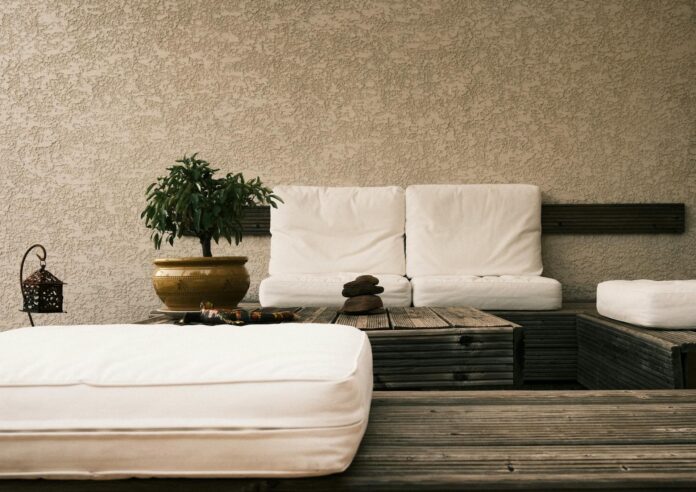Contesto Storico e Culturale
Gli anni ’70 furono un periodo di significativi cambiamenti sociali e culturali, riflessi chiaramente nel design e negli arredi dell’epoca. Alla fine degli anni ’60 e all’inizio degli anni ’70 si assistette a un movimento verso l’espressione individuale, la libertà di pensiero e un forte desiderio di distaccarsi dalla tradizione. Questo contesto influenzò profondamente il design d’interni, portando a design audaci, forme innovative e un uso esuberante del colore.
Gli anni settanta furono un periodo di transizione e sperimentazione, non solo a livello sociale e culturale, ma anche nel campo del design d’interni e degli arredi. Questo decennio, collocato tra il fermento rivoluzionario della fine degli anni ’60 e l’inizio del conservatorismo degli anni ’80, rifletteva un’epoca di contrasti: da un lato, l’aspirazione a una maggiore libertà espressiva e, dall’altro, una crescente consapevolezza ecologica e sociale.
Il movimento controculturale che aveva preso radici alla fine degli anni ’60 si tradusse negli anni ’70 come un’aspirazione all’espressione individuale e all’esplorazione di nuovi modi di vivere. Il design e gli arredi di quegli anni divennero portavoce di questo spirito di ribellione, rompendo con le convenzioni tradizionali e i canoni estetici. Il risultato fu uno stile eclettico che mescolava influenze dalla pop art, dal minimalismo, dall’arte psichedelica e dall’interesse crescente per il futurismo e la tecnologia.
In questo contesto, la casa era vista come un’estensione della personalità individuale, un luogo dove sperimentare forme, colori e materiali. Gli arredi degli anni Settanta riflettono questa visione, concentrandosi su spazi abitativi funzionali, confortevoli ed espressioni di un’estetica personale e distintiva.
Allo stesso tempo, il decennio vide una crescente consapevolezza delle questioni ambientali e sociali, influenzando il settore dell’arredamento con l’introduzione di materiali meno inquinanti e più sostenibili, nonché design che favorivano la multifunzionalità e l’efficienza dello spazio, in risposta a una maggiore consapevolezza dell’impatto ambientale del consumo e della produzione industriale.
Così, gli anni ’70 furono un periodo di grande fermento e innovazione nel campo del design d’interni, contraddistinto da intensa sperimentazione formale e dall’adozione di nuovi materiali e tecnologie. Questo contesto storico e culturale ha lasciato un’eredità duratura, influenzando profondamente le generazioni successive di designer e plasmando la nostra comprensione dello spazio abitativo come luogo di espressione personale e benessere.
Caratteristiche Distintive
Lo stile degli arredi degli anni Settanta si distingue per diverse caratteristiche chiave:
Forme e Design: prevalenza di linee curve, forme organiche e angolari, e un approccio spesso “futuristico” per l’epoca.
Focus sul Comfort e sull’Usabilità: gli arredi non erano solo pezzi artistici, ma dovevano anche essere confortevoli e funzionali.
Spazi Aperti e Multifunzionali: gli arredi sono stati progettati per essere versatili, spesso modulari, per adattarsi a spazi aperti e promuovere l’interazione sociale.
Gli arredi degli anni Settanta sono riconoscibili per le caratteristiche distintive che li rendono unici rispetto ad altri periodi storici, mostrando un mix innovativo di estetica, funzionalità e sperimentazione.
Forme e Design
Durante gli anni Settanta, vi fu una vera rivoluzione nel design degli arredi, con l’emergere di forme mai viste prima. Questo decennio fu contraddistinto da un forte interesse per forme organiche, ispirate dalla natura, ma anche forme geometriche e angolari, spesso risultando in arredi che sembravano opere d’arte moderne. Sedie, divani e tavoli abbandonarono le linee rigide per curve sinuose, spigoli vivi e silhouette non convenzionali, spesso ispirate al movimento futurista e alla fantascienza, riflettendo una prospettiva orientata all’innovazione e al futuro.
Focus sul Comfort e sull’Usabilità
Nonostante l’audacia estetica, gli anni Settanta non trascurarono la funzionalità. I designer di quel periodo diedero grande importanza al comfort e all’usabilità degli arredi. Divani e poltrone furono progettati per offrire il massimo relax, spesso con imbottiture generose e rivestimenti in tessuti morbidi e accoglienti. Questo decennio vide anche la diffusione di arredi modulari e trasformabili, capaci di adattarsi a diverse esigenze e spazi, riflettendo l’ideale di versatilità e funzionalità che caratterizzava l’epoca.
Spazi Aperti e Multifunzionali
La concezione degli spazi abitativi subì una profonda trasformazione negli anni Settanta. L’idea era quella di creare ambienti aperti, fluidi e multifunzionali che facilitassero l’interazione tra le persone e promuovessero uno stile di vita più libero e informale. Questo approccio si rifletteva nella scelta di arredi modulari e riconfigurabili che potessero essere facilmente spostati o adattati secondo le esigenze. La cucina, ad esempio, si aprì al soggiorno, diventando uno spazio unico per cucinare, mangiare e socializzare, simboleggiando la rottura con la tradizionale divisione degli ambienti domestici.
Sperimentazione e Innovazione
Gli anni Settanta furono un periodo di grande sperimentazione, non solo nelle forme e nell’uso dello spazio, ma anche nell’adozione di nuovi materiali. Plastica, plexiglass, cromo, vetro e legno laminato divennero materiali comuni, scelti per la loro versatilità e la capacità di essere modellati in forme senza precedenti. Questa apertura verso nuovi materiali e tecniche di produzione contribuì a definire il look unico degli arredi di quel decennio, caratterizzato da una straordinaria varietà di texture, superfici ed effetti visivi.
In sintesi, le caratteristiche distintive degli arredi degli anni Settanta riflettono un periodo di intensa innovazione e sperimentazione. La combinazione di audaci estetici, attenzione al comfort e alla funzionalità, ed esplorazione di nuovi materiali e soluzioni spaziali, diede vita a un’epoca memorabile nel campo del design d’interni, le cui influenze sono ancora palpabili nel design contemporaneo.
Materiali e Colori
L’uso di una vasta gamma di materiali e colori è una delle caratteristiche salienti degli arredi di questo decennio:
Materiali: preferenza per plastica, cromo, vetro e legno laminato, oltre ai tradizionali legni massicci e tessuti.
Colori: i toni erano vibranti e variavano dal giallo al verde avocado, dall’arancione al marrone, con accenti di colori psichedelici per sottolineare l’audacia e la creatività del periodo.
Influenza sul Design Contemporaneo
Il lascito degli arredi degli anni Settanta persiste nel design contemporaneo, con una rivisitazione di alcuni elementi chiave come l’uso audace del colore, il recupero delle forme organiche e la valorizzazione di spazi aperti e multifunzionali. Designer e decoratori d’interni continuano a trarre ispirazione da quel decennio per creare ambienti che combinano comfort, funzionalità e uno stile unico.
Gli arredi degli anni Settanta offrono uno sguardo affascinante su un’epoca di transizione nel design, riflettendo cambiamenti sociali e culturali attraverso scelte audaci e innovative. La sua influenza rimane evidente nel modo in cui pensiamo e viviamo i nostri spazi abitativi oggi, dimostrando che il design di quel decennio aveva una visione del futuro che continua a ispirarci.
Questo testo fornisce una panoramica sugli arredi degli anni ’70, evidenziandone le caratteristiche distintive, i materiali, i colori e l’influenza sul design contemporaneo, ed è strutturato per garantire una lettura piacevole e informativa.
L’impatto degli arredi degli anni Settanta sul design contemporaneo è vasto e sfaccettato, evidenziando come le idee, i materiali e le forme di un’epoca possano essere reinterpretati e adattati ai cambiamenti sociali e culturali, continuando a ispirare innovazione e creatività nel campo del design d’interni.
Ig – @fairness_mag




